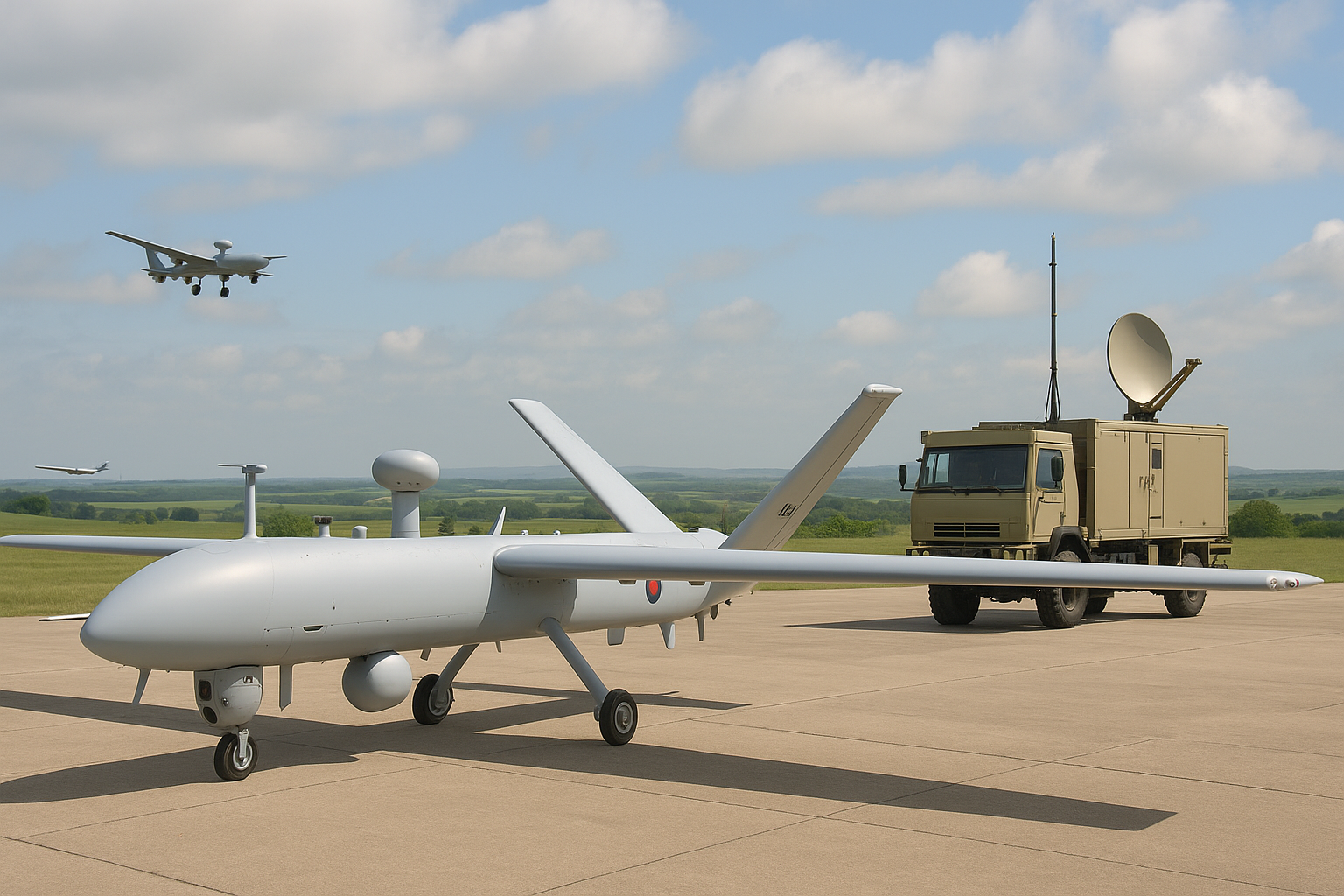The Ministry of Defence has signed a £700 million agreement with Thales UK to develop, manufacture, and support the Watchkeeper unmanned system. The single signature secures every major phase of work, from completing design through initial sustainment, under one integrated schedule.
Watchkeeper forms a core element of the Network-Enabled Capability drive. It gives commanders an organic intelligence, surveillance, target-acquisition, and reconnaissance asset that links directly into existing ground and joint networks. Earlier projects like the Taranis stealth UCAV helped define British uncrewed doctrine that shaped Watchkeeper’s role. The programme will start fielding equipment in 2010, keeping pace with restructuring plans for the Royal Artillery.
Thales Watchkeeper WK450 Mission Systems
The contract covers not only air vehicles but also training courses, simulators, containerised mission stations, and purpose-built facilities on Salisbury Plain. Thales commits to meet strict cost and schedule gates that tie payment to demonstrated performance rather than paperwork alone.
Each WK450 air vehicle carries an electro-optical turret, a synthetic-aperture radar, and a laser designator. Endurance exceeds sixteen hours without in-flight refuelling. It launches from rough strips, climbs above 15 000 ft, and sends full-motion video through encrypted data links straight into the tactical headquarters.
Crucially, Watchkeeper can orbit contested airspace while crews remain inside armoured shelters miles away. That separation removes the need to expose patrols or manned aircraft to small-arms or short-range missile fire during routine reconnaissance.
Early operational analysis predicts a typical two-aircraft detachment will create continuous coverage over a 100 km radius. One vehicle loiters below cloud, the other sits higher to relay line-of-sight traffic back to base. The arrangement boosts resilience if mountain ridges or urban skylines mask normal links.
UK Watchkeeper Drone Deployment and Combat Integration
Core system elements:
- WK450 air vehicle – composite airframe, dual-redundant avionics, de-icing kit
- Day/night sensor suite – high-resolution camera, MWIR imager, SAR-GMTI radar
- Laser target designator – NATO-standard codes for precision-guided munitions
- 20-foot ground control station – room for two pilots, a mission commander, and, when required, an image analyst
- Tactical common data link – Ku-band antenna with embedded COMSEC module
The ground segment rides on the Army’s existing Demountable Rack Off-load and Pick-up System truck fleet. Crews lift a mission pod on or off in minutes, giving divisional staff genuine freedom to redeploy without contracting heavy transports.
Thales Watchkeeper WK450 Industrial Base and Export Potential
Alex Dorrian, chief executive of Thales UK, described the award as “our largest home-market win to date, and one that will anchor thousands of skilled posts for a decade.” He added that export prospects could add “at least £400 million” in additional sales once deliveries prove performance.
Thales group chairman Denis Ranque emphasised the strategic value: “Watchkeeper locks Thales firmly into the global UAV sector while deepening our British industrial base. The solution showcases real ISTAR expertise that partners abroad already want to mirror.”
Company economists forecast direct or sustained work for roughly 2 100 engineers, technicians, and logisticians across the United Kingdom. Should overseas customers join later production blocks, that figure may climb beyond 2 500.
Thales–Elbit Joint Venture Anchors British UAV Manufacturing
Central to domestic content is UAV Tactical Systems Ltd, a Leicester joint venture between Thales and Elbit Systems. The plant will assemble wings, integrate sensor bays, and conduct acceptance flights before handing airframes to the Army. A £70 million test range opened at ParcAberporth, West Wales, gives crews permanent airspace for envelope expansion and software regression.
The MoD selected Thales in July 2004 after a hard-fought competition that also involved Northrop Grumman. Since preferred-bidder announcement, the team simplified architecture: both high-altitude relay and low-altitude collector roles now use the same WK450 type, improving logistics and easing pilot conversion.
Design reviews enlarged the control shelter to the full ISO-20 standard. Extra floor space leaves room to fit a dedicated imagery analyst position when operations demand rapid exploitation rather than reach-back to a rear HQ.
Programme finance totals about £800 million after adding MoD oversight, government-furnished trucks, and new infrastructure. Officials stress the value equates to four percent of the Defence Equipment Plan for the current spending period – modest compared with manned fast-jet projects offering similar sensor reach.
The development schedule includes four milestones: preliminary design complete by mid-2006; first flight of a production-representative airframe in 2007; initial operator training at Boscombe Down in 2008; and declaration of initial operating capability in 2010.
Testing will check automatic take-off and landing, encrypted datalink robustness, and sensor fusion. QinetiQ, Marshall SV, Boeing UK, and LogicaCMG each bring niche modules into the integrated baseline under firm-priced subcontracts.
British gunners of 32 Regiment Royal Artillery already operate leased Hermes 450 drones in Iraq. That deployment feeds Watchkeeper design feedback straight from the field, ensuring procedures and software match real combat needs.
Future Watchkeeper Upgrades May Include Radar and Strike Payloads
Thales confirms the Watchkeeper air vehicle can accept future payloads once power and weight margins permit. Candidate upgrades include synthetic-aperture ground-moving-target radar, hyperspectral cameras, radio-frequency geolocation aerials, and potential lightweight weapons. This aligns with recent drone-UGV logistics mission concepts now championed by the European Defence Agency.
Export marketing targets three near-term opportunities:
- a Canadian land forces intelligence requirement due for tender in 2007;
- a French interim tactical UAV order linked to FELIN infantry gear;
- a Polish border-security package aligned with Schengen obligations.
Success in any of those bids could extend Leicester production well beyond the UK batch.
BACKGROUND NOTES
– Total MoD expenditure: approximately £800 million, including the £700 million Thales contract plus ancillary costs.
– Two main improvements since July 2004 selection:
- Single airframe type for both relay and collector roles, easing fleet management.
- Larger ground station shell, creating growth space for extra consoles.
Thales employs 60 000 people worldwide, of whom 10 000 work in the United Kingdom. Group revenue reached €10.3 billion in 2004.
Watchkeeper Drone Advancements – 2025 Update
Nearly twenty years after signature, the Watchkeeper story now closes. The Army accepted 47 air vehicles, not the 54 once planned, and declared full operational capability only in late 2019 after a decade of setbacks.
Technical troubles dogged the fleet. Moisture-blocked pitot probes, flight-control software faults, and poor visibility grounding orders caused eight hull-loss accidents between 2014 and 2022. Investigators attributed several mishaps to inadequate system understanding rather than enemy action.
Attrition and redesigns pushed cumulative spend past £1.35 billion – almost double the 2005 forecast. Parliament’s Public Accounts Committee labelled the programme “a troubling example of requirements creep and unrealistic optimism.”
Despite doubts, Watchkeeper flew border security sorties over the English Channel under Operation Devran in 2020. Sensors proved valuable for small-boat detection, yet weather windows remained tight, forcing crews to switch training flights from Wales to Ascension Island during winter.
By November 2024 the Defence Secretary announced that Watchkeeper would leave service by the end of March 2025. He argued that modern conflict, highlighted by Ukrainian drone innovation, demands swarms able to survive jamming, not single expensive airframes that struggle in rain. This shift coincided with efforts to protect funding for Watchkeeper’s replacement under the rapid-acquisition Project Corvus.
Retirement also releases resources: support contracts worth tens of millions per year will now fund a rapid procurement effort called Project Corvus. The new requirement seeks a family of modular, runway-independent aircraft delivering twenty-four-hour “deep-find” coverage at corps level.
Under Corvus, Defence Equipment & Support issued a preliminary market notice in April 2025, asking industry for concepts that can reach readiness within thirty-six months. Several responses explore concepts akin to the one-way drone approach now emerging as cost-effective alternatives to legacy ISR platforms. Thales confirmed it will bid with a redesigned platform drawing lessons from its Franco-British Spy’Ranger trials.
The Watchkeeper withdrawal mirrors broader inventory cuts, including Puma helicopters and selected frigates, aimed at redirecting capital into electronic warfare, long-range fires, and artificial-intelligence-enabled command systems.
Most surviving airframes will move into climate-controlled storage at a MoD site near Kineton while disposal options – sale to allies, conversion to targets, or museum display – are assessed. Thales retains intellectual-property rights, easing future export refurbishment should a buyer emerge.
Recent crash highlights
- WK050 ditched near Aberporth on 13 June 2018 after a blocked pitot tube confused the autopilot.
- WK043 struck high ground on 24 March 2017 in cloud when inertial sensors desynchronised.
- A training airframe fell into the Mediterranean off Cyprus on 26 December 2020 during cross-wind landing practice.
Additional crash records compiled by watchdogs reveal the scale of technical issues Watchkeeper faced. With Watchkeeper now grounded, 47 Regiment Royal Artillery moves to interim quad-rotor and fixed-wing small UAS while awaiting Corvus. Officers insist ISR demand has not shrunk – only the platform mix has changed.
Thales, for its part, calls the original contract “a catalyst for UK UAV expertise” and notes that sensor and datalink modules derived from Watchkeeper already feed newer products. Lessons from twenty years of trials, crashes, and contested deployments shape the next chapter in British uncrewed aviation.
REFERENCE SOURCES
- https://aerospaceglobalnews.com/news/the-troubled-watchkeeper-story-draws-to-a-close/
- https://www.theengineer.co.uk/content/news/thales-uk-awarded-700-million/
- https://en.wikipedia.org/wiki/Thales_Watchkeeper_WK450
- https://dronewars.net/tag/crashes/
- https://www.theguardian.com/world/2020/dec/26/british-military-drone-crashes-during-cyprus-training-flight
- https://www.theregister.com/2019/04/15/watchkeeper_drone_crash_wk042_moisture_blocked_pitot/
- https://www.lbc.co.uk/news/british-army-watchkeeper-drone-program-scrapped/
- https://ukdefencejournal.org.uk/britain-to-retire-fleet-of-watchkeeper-drones/
- https://questions-statements.parliament.uk/written-statements/detail/2024-11-20/hcws239
- https://www.shephardmedia.com/news/air-warfare/uk-mod-unveils-first-steps-for-british-army-watchkeeper-replacement/
- https://www.janes.com/osint-insights/defence-news-details/air/uk-spells-out-corvus-uas-requirement-to-replace-watchkeeper
- https://breakingdefense.com/2024/12/uk-looks-to-protect-funding-for-rapid-watchkeeper-uav-replacement/
- https://theaviationist.com/2024/11/20/uk-announces-cuts/



